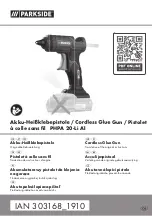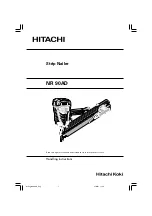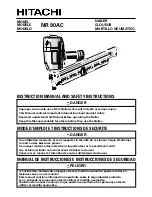
TOOLS WITH A SAFETY TRIP- THREE OPERATING TYPES POSSIBLE.
All tools with a safety trip are marked with an inverted equilateral triangle (
▼
). Do not attempt to use a tool marked in this
way if the safety trip is missing or appears damaged.
SEQUENTIAL TRIP
(Reference 2 in Technical Data Table, column L)
The sequential trip requires the operator to hold the tool against the work with the safety trip depressed
before pulling the trigger. In order to drive additional fasteners, the trigger must be released and the tool
lifted away from the work, before repeating the above mentioned steps. This makes accurate fastener
placement easier, for instance on framing, toe nailing and crating applications. The sequential trip
allows exact fastener location without the possibility of driving a second fastener on recoil, as described
under Contact Trip (below). The sequential trip tool has a positive safety advantage because it will not
accidentally drive a fastener if the tool is contacted against the work - or anything else - while the operator is holding the
trigger pulled.
CONTACT TRIP (N89C-1: SERIAL NUMBER 07315XXX ONWARDS)
(Reference 1 in Technical Data Table, column L)
The common operating procedure on "Contact Trip" tools is for the operator to actuate the safety trip
while keeping the trigger pulled, thus driving a fastener each time the work is contacted. This will allow
rapid fastener placement on many jobs, such as sheathing, decking and pallet assembly. All pneumatic
tools are subject to recoil when driving fasteners. The tool may bounce, releasing the safety trip and if
unintentionally allowed to re-contact the work surface with the trigger still actuated (finger still holding
the trigger pulled) an unwanted second fastener will be driven.
These tools are labeled with a "do not use on stairs or ladders" symbol. Technical Data Table Illustration. Tools marked with
this symbol must not be used where changing from one working position to another involves the use of ladders, stairs or
similar structures such as roof laths.
CONTINUOUS CONTACT OPERATION.
(Reference 4 in Technical Data Table, column L)
The Continuous Contact Operation Tools allow driving cycles to be repeated for as long as the trigger and the safety trip
remain actuated.
These tools may only be used where the length of the fastener does not exceed 65 mm. and they are also labeled with a "do
not use on stairs or ladders" symbol. See Technical Data Table Illustration. Tools marked with this symbol must not be used
where changing from one working position to another involves the use of ladders, stairs or similar structures such as roof
laths.
DIRECTIONAL EXHAUST DEFLECTOR (FIG. 4: N64-084, N64-099, N89C)
The adjustable exhaust deflector can be rotated to any desired position by hand without the use of any tools.
FASTENER DEPTH CONTROL ADJUSTMENT (FIG 5)
The Fastener Depth Control Adjustment feature provides control of the nail drive depth from flush with or just above the work
surface to shallow or deep countersink.
Warning!
Disconnect tool from air supply before attempting any parts disassembly and before changing the work contacting
element adjustment.
1. Push in Locking Button
2. Adjust contact arm up to increase depth of drive or down to decrease it.
3. Release locking button.
UTILITY HOOK (N89C-2- Fig 6)
These tools include an additional utility hook suitable for storage and temporary hanging of the tool.
WARNING! Never use the utility hook to hang the tool from the body, clothing or belt.
WARNING! Never use the utility hook with contact (black) trigger operated tools.
GREY TRIGGER
BLACK TRIGGER
FT70950-c-1111_Coil_Nailers_Manual:70950_CoilNailing_Manual_Update 11/30/11 9:44 AM Page 6







































